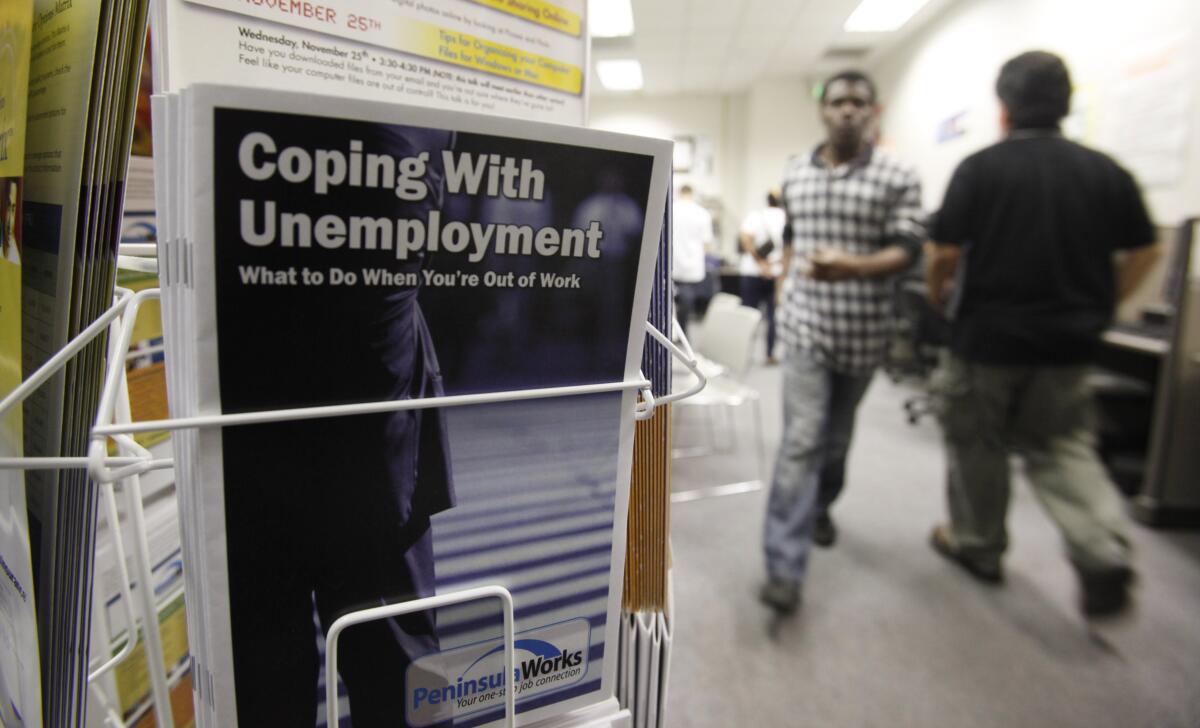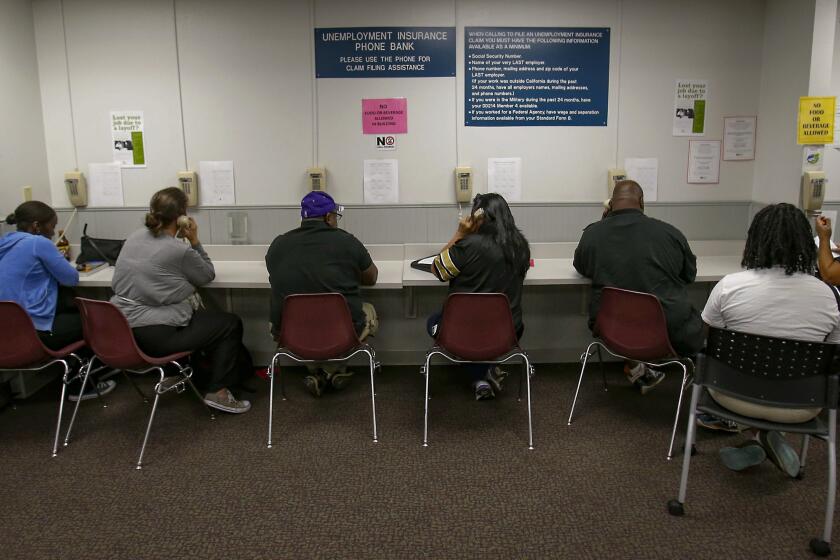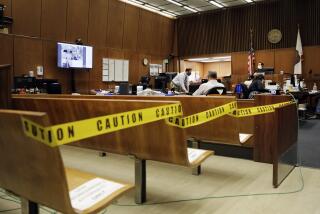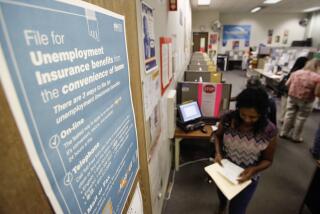Californians will again have to show they’re job hunting to receive unemployment benefits

- Share via
SACRAMENTO — With the pandemic waning, Californians who receive unemployment benefits will have to show next month that they are looking for work, a requirement that the state waived last year when COVID-19 led to economic upheaval.
Claimants for unemployment benefits must start job hunting July 11 so they can attest that they are doing so when certifying their eligibility a week later with the state Employment Development Department, the agency announced Thursday.
To show they are looking for work, unemployment benefit recipients can create an account at the state’s CalJOBS website and post a profile on various job search sites, said Rita Saenz, director of the EDD. They can also apply for suitable jobs or let prior employers and community members know they are looking for work to satisfy the requirement.
“We want to make sure those on unemployment have enough lead time to start searching for work so they can remain eligible for benefits as they seek their next career opportunity,” Saenz said Thursday.
The process for obtaining unemployment benefits in California is changing, including a job search requirement. Here’s what you need to know.
Faced with an unprecedented 22.5 million unemployment claims, the state in March 2020 temporarily waived the work search requirement to expedite payment of benefits and to recognize that there were potential health risks involved in returning to jobs while the pandemic was raging.
Requiring people to search for work was also at odds with the state’s stay-at-home order, which discouraged people from going to workplaces for nonessential jobs.
Though the state lifted many COVID-related restrictions this week on physical distancing and capacity at businesses, some state officials expressed concern Thursday that uncertainty remains over the economy as stores, restaurants and other employers report difficulty in attempting to fill job vacancies.
“If we continue to have an employment rate that’s [higher than] the national average and don’t have enough people in the workforce, this recovery could go south very fast,” said Assemblywoman Cottie Petrie-Norris (D-Laguna Beach). “As we emerge from this pandemic, it is critical to get Californians back to work so we can get our economy firing.”
Others questioned the timing of the return to the old policy when hundreds of thousands of jobless Californians are still seeing delays in receiving benefits from the EDD.
“At some point, it does make sense to reintroduce this requirement,” said Assemblyman David Chiu (D-San Francisco). “However, given that EDD still has a massive backlog of unpaid claims and has consistently struggled to implement new requirements, I worry this may not be the time to introduce another hurdle.”
The EDD has paid $150 billion in benefits since the pandemic began last year, but many jobless Californians say they are still having trouble getting the money they need from the agency.
The new policy comes as the EDD reports a backlog of 1.12 million claims that have seen approval delayed by more than 21 days. More than 222,500 of those claims are awaiting action by EDD, an increase from earlier in the month.
The rest have not been approved because the claimant needs to verify identity and eligibility, officials say, although some jobless people say glitches at the state agency have prevented them from doing so.
People who lost work during the pandemic said Thursday they can comply with the new requirement.
“I feel like it’s a nominal requirement,” said Roneisha Williams, who was an executive assistant and restaurant worker before the pandemic.
Like many people, Williams has had problems receiving help from the EDD, including getting through on jammed phone lines and getting benefits paid without delay.
“It’s been challenging from the start,” said the South Bay resident.
Williams has been looking for work but thinks the state should have been proactively helping her and others find new jobs.
But given the EDD’s past problems at implementing changes, the new policy has some unemployed people worried that there will be new hiccups that make it difficult to meet the requirement and avoid an interruption of benefits.
The skeptical include Mark Roman, an actor and street performer who has seen his benefits frozen off and on since he lost work. He said he has been sent EDD mail in Spanish, a language he doesn’t speak, and documentation that incorrectly identified him as a waitress.
“It’s been bumps and starts,” said the Hollywood resident. Roman said he gets 80% of his work through Central Casting so he does not believe it should be hard for him to show that he is looking for work.
Under the restored policy, people certifying eligibility every two weeks starting July 18 will see new help text on the forms and guidance to assist claimants in assessing whether they can answer “yes” to the biweekly certification that they are looking for work.
Officials said some people may be asked to provide backup documentation supporting an attestation to EDD if questions arise regarding their eligibility.
People who answer “no” on the certification form will be asked further questions and may be scheduled for an interview to determine benefit eligibility, the agency said.
For those who are gig workers or are self-employed and get benefits from the Pandemic Unemployment Assistance program, the EDD is providing other ways to show they are searching for work, including submitting bids for contracts, attending networking events and workshops on expanding businesses, and participating in training.
EDD officials said claimants can still ask for exemptions if they certify that they are not available for work for reasons including providing primary child care for their family.
Republican Assemblyman Jim Patterson of Fresno, a leading legislative critic of the EDD, said that the growing backlog remains a concern but that he believes people should be looking for work while they get benefits.
“Our state’s anemic reopening over the last several months meant that many people couldn’t go back to work,” Patterson said. “Now that Gov. Newsom has decided we can all return to life as normal, it seems appropriate to reinstate the requirement to look for work.”
More to Read
Sign up for Essential California
The most important California stories and recommendations in your inbox every morning.
You may occasionally receive promotional content from the Los Angeles Times.












